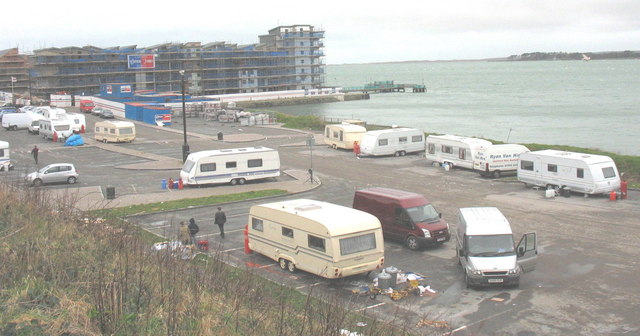
Suočeni s mnogim stereotipima i velikom diskriminacijom, irski Putnici su jedna od neshvaćenih manjinskih skupina u Ujedinjenom Kraljevstvu. Vrlo prisutni u britanskom društvu, tko su oni zapravo?
Prijevod: Zvonimir Rajković
Iako prvi tragovi Putnika u Engleskoj datiraju iz dvanaestog stoljeća, većina ih je 1850. godine stigla iz Irske, tijekom Velike gladi uzrokovane lošim urodom krompira. Slično kretanje iz Irske u Englesku dogodio se nakon Drugog svjetskog rata, kada su irski Putnici došli u Englesku kao radnici, uglavnom graditi autoceste.
Od 2002. godine Putnici su prepoznati kao nacionalna manjina, a kao takvi su službeno priznati Zakonom o ravnopravnosti 2010. godine. To znači da su zaštićeni i Zakonom o rasnim odnosima kojim je kriminalizirana diskriminacija manjina.

Važno je napomenuti da, unatoč svom imenu, te iako ih negativni stereotipi prikazuju u svjetlu ilegalnog kampiranja na neovlaštenim mjestima, nisu svi Putnici trajni nomadi. Ovaj stereotip, međutim, nije toliko raširen koliko stereotipi to inače mogu biti, a novine 'Travellers Times' navodi da se to odnosi samo na mali broj Putnika.
U Ujedinjenom Kraljevstvu, kad se spomenu Putnici, jedna od prvih asocijacija koju će ljudi imati je Dale Farma. Smještena u Grofoviji Essex, ovo je bilo najveće mjesto u Ujedinjenom Kraljevstvu na kojem borave Putnici. U očima zakona, ipak, dio toga područja bio je naseljen ilegalno. U 2011. godini deložirano je 80 obitelji, uhićeno 45 osoba, i pri tom ozlijeđeno 15 policajaca.
Na tom je području sveukupno bilo 40 parcela s dozvolama, ali je korišteno više nego dvostruko, a procjenjuje se da je tamo živjelo oko 400 ljudi. Bio je to vrlo traumatičan događaj. I oni evakuirani i oni kojima je ostanak bio dopušten i dalje su osjećali posljedice tog događaja pet godina kasnije, kad su bili intervjuirani. Doista, mnogi od njih vjeruju da je ova evakuacija stvorila više problema nego što ih je riješila, jer mnogi od njih sada žive na mjestima poput parkirališta supermarketa.
Također, iako se automatski misli na irske Putnike kad se govori o Putnicima u Velikoj Britaniji, važno je naglasiti da postoje i druge skupine koje također nose naziv ‘Putnik’. U njih spadaju ‘britanski Showmen’, poznati i kao sajamski Putnici, koji su porijeklom iz Velike Britanije te putuju po sajmovima i cirkusima.
Druga skupina poznata kao Putnici u Ujedinjenom Kraljevstvu su ‘Romanichal Putnici’, poznati i kao ‘engleski Gypsies’ ili engleski Putnici. Oni su nacionalna skupina romskog podrijetla. Ostale skupine uključuju škotske Putnike i velške Putnike.
Na popisu stanovništva iz 2011. godine 0,1% stanovništva Ujedinjenog Kraljevstva izjasnilo se kao Rom ili Putnik, no ta je brojka najvjerojatnije veća zbog onih koji se odbijaju izjasniti o svojoj nacionalnoj pripadnosti zbog negativnih stereotipa.

Facing many stereotypes and much discrimination, Travellers are one of the misunderstood minority groups in the United Kingdom. Very prevalent in British society, who are they exactly?
The first traces of Travellers in the England date back to the twelfth century, but they most arrived in great numbers in the 1850 from Ireland, during the Irish potato famine. A similar movement from Ireland to England happened after the Second World War – Irish Travellers came over to England to work as labourers, mainly building motorways.
Since 2002, Travellers have been recognised as an ethic minority and are legally recognised as such under the Equalities Act 2010. This means that they are also protected by the Race Relations Act. This act criminalises discriminations towards minorities.
It is important to mention that, despite their name, not all Travellers are permanently itinerant, and, even though they’re subject to negative stereotypes depicting them illegally camping in unauthorised spots. This is however not as prevalent as stereotypes let the general public believe, and the newspaper ‘Travellers Times’ states that this only concerns a small number of travellers.
In the United Kingdom, when Travellers are mentioned, one of the first things people will think of is Dale Farm. Located in the county of Essex, this was the UK’s largest traveller site. In the eyes of the law however, part of it was an illegal settlement. In 2011, 80 families were evicted, 45 people arrested, and 15 police officers injured.
In total, there were 40 authorised plots at Dale Farm, but, in reality, more than twice as many were being used, with an estimated 400 people living there. This was a traumatic event for those involved, and the evacuated people and those who were allowed to stay still felt the effects of it when interviewed five years later. Indeed, many of them believe that the evacuation created more problems than it solved, with many of them now living in the likes of supermarket carparks.
It is also important to point out that, even though, when we refer to travellers in the UK, the automatic association is to Irish travellers, but there are also other groups which go by the name “Traveller”. These include British showman, also known as funfair travellers who are native to Great Britain and travel in funfairs and circuses.
Another group known as Travellers in the United Kingdom are Romanichal Travellers, also known as English Gypsies or English Travellers. They are a Roma ethnic group of Roma origin. Other groups include Scottish Travellers and Welsh Travellers.
In the 2011 census, 0,1% of the population of the United Kingdom identified themselves as Gypsy or Traveller, but the figure is most likely higher, due to an amount of them withholding their ethnic background due to negative stereotypes.